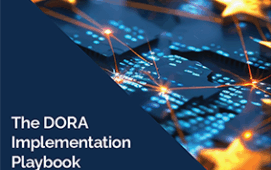
Artificial Intelligence (AI) has swiftly transitioned from a promising concept into an operational reality across the capital markets. Senior executives, compliance leaders, and technology specialists are already well-acquainted with the potential of AI to streamline processes, enhance decision-making, and open new competitive opportunities. Yet, the current challenge isn’t about grasping AI’s transformative potential – it’s about understanding precisely how to integrate these technologies effectively into complex workflows, governance structures, and compliance frameworks.
Experienced professionals navigating the evolving financial landscape, are tasked not with theoretical discussions but with practical implementation – managing risks, ensuring regulatory compliance, and aligning AI initiatives with clearly defined strategic objectives. Moving beyond the hype to grapple with concrete questions like: What approaches to adoption best fit our organisation’s digital maturity? How do we balance AI-driven innovation with the strict demands of regulatory oversight? And crucially, what are the ethical and governance considerations that can no longer be sidelined?The AI in Capital Markets Handbook 2025 from A-Team Group is specifically crafted to address these concerns. Rather than repeating the general industry narrative, this practical guide offers actionable frameworks, clear guidance, and realistic insights tailored explicitly to seasoned practitioners. By emphasising effective implementation strategies, robust governance practices, and forward-looking perspectives on emerging trends, the handbook serves as a reliable resource for decision-makers focused on achieving tangible results and maintaining a responsible approach to AI.
In the following sections, we’ll explore the distinctive value this handbook delivers, illustrating precisely how it can help convert strategic intent into practical outcomes, strengthen compliance readiness, and confidently prepare for the future.
The AI in Capital Markets Handbook 2025 is tailored specifically for senior-level professionals operating within the financial services industry. Strategic decision-makers benefit from clearly articulated adoption models, enabling thoughtful investment choices aligned with long-term objectives.
Technology leaders will find practical, actionable guidance on infrastructure requirements, talent management, and implementation strategies that drive operational effectiveness. For compliance leaders, the handbook offers precise insights into regulatory frameworks, helping you understand and implement AI responsibly and transparently.
Understanding the Real Value of AI
Today’s financial markets are driven by complexity, competition, and rigorous regulatory standards. Senior executives are tasked with navigating these challenges effectively, deploying advanced technologies that deliver measurable operational improvements. The Handbook explicitly addresses this need, offering practical insights to bridge the gap between theoretical knowledge and actionable implementation. The handbook acknowledges that the priority isn’t just knowing what AI can theoretically achieve, but understanding precisely how these capabilities can be practically applied within the organisation to deliver real value.
With a clear focus on actionable outcomes, the handbook guides the reader through realistic scenarios where AI technologies impact workflows, governance structures, and strategic compliance efforts. It sets aside abstract promises and instead helps tackle specific problems such as automating complex compliance processes, managing risks associated with non-transparent models, and embedding robust governance to maintain trust. This emphasis on practical guidance makes the handbook a practical tool for ensuring that investments in AI directly align with tangible business and compliance objectives.
Comprehensive Yet Practical
The value of the AI in Capital Markets Handbook 2025 lies in its thoughtful, structured approach. By systematically examining how AI technologies intersect with each stage of the trade lifecycle – from pre-trade research through execution and into post-trade processes – the handbook ensures clarity and comprehensiveness without becoming overwhelming. Each section is crafted to equip senior professionals with the precise level of detail required to make informed strategic decisions, avoiding both superficial overviews and overly technical jargon.
Infrastructure considerations are tackled in a similarly practical manner, providing an understanding of exactly what is needed in terms of cloud adoption, data integration, and computing resources.
Informed Strategies, Not Buzzwords
While the industry remains saturated with buzzwords and lofty promises, senior leaders recognise the importance of responsible and strategic implementation over hype-driven adoption. The handbook highlights real-world experiences and credible industry examples – such as JP Morgan’s OmniAI initiative and Goldman Sachs’ approach to AI-driven risk management – to illustrate proven pathways and realistic expectations.
Moreover, the handbook addresses the practicalities of operational risk and governance, providing clear guidance on managing AI’s inherent complexities. Readers will find valuable perspectives on how to implement robust control mechanisms and ensure accountability and transparency in AI systems – key aspects for maintaining regulatory compliance and securing stakeholder trust.
Aligning AI with Compliance and Ethical Best Practices
Compliance and ethical considerations are at the forefront of AI adoption, particularly as regulators sharpen their scrutiny. The Handbook directly addresses these concerns by outlining clear governance frameworks aligned with major regulatory guidelines, including the EU AI Act, GDPR, and emerging regulatory positions from the SEC and FCA. Recognising that regulatory expectations continue to evolve, the handbook provides senior compliance and regulatory affairs leaders with clear, up-to-date guidance on aligning AI deployments with these standards.
By explicitly tackling explainability, transparency, and data privacy, the handbook positions itself as a helpful resource for navigating AI’s intersection with compliance mandates and confidently articulating the firm’s AI governance strategy to regulators, stakeholders, and clients alike.
Looking Ahead – Practical Futureproofing
In a rapidly evolving technological landscape, the handbook doesn’t merely address current best practices – it also addresses what lies ahead. It reviews the trajectory of emerging AI trends, including generative AI, agentic AI systems, and retrieval-augmented generation (RAG). By offering concrete insights into these innovative developments, it helps senior executives and technology leaders anticipate near-future scenarios and proactively integrate relevant innovations into their strategic plans.
For experienced capital markets professionals seeking clarity, practicality, and strategic insight rather than more AI hype, the Handbook offers a balanced and credible resource. By delivering actionable guidance grounded in real-world applicability, it provides the strategic frameworks, compliance clarity, and future-focused analysis you need to effectively navigate your AI journey.
Download Your Free AI in Capital Markets Handbook 2025
Subscribe to our newsletter




